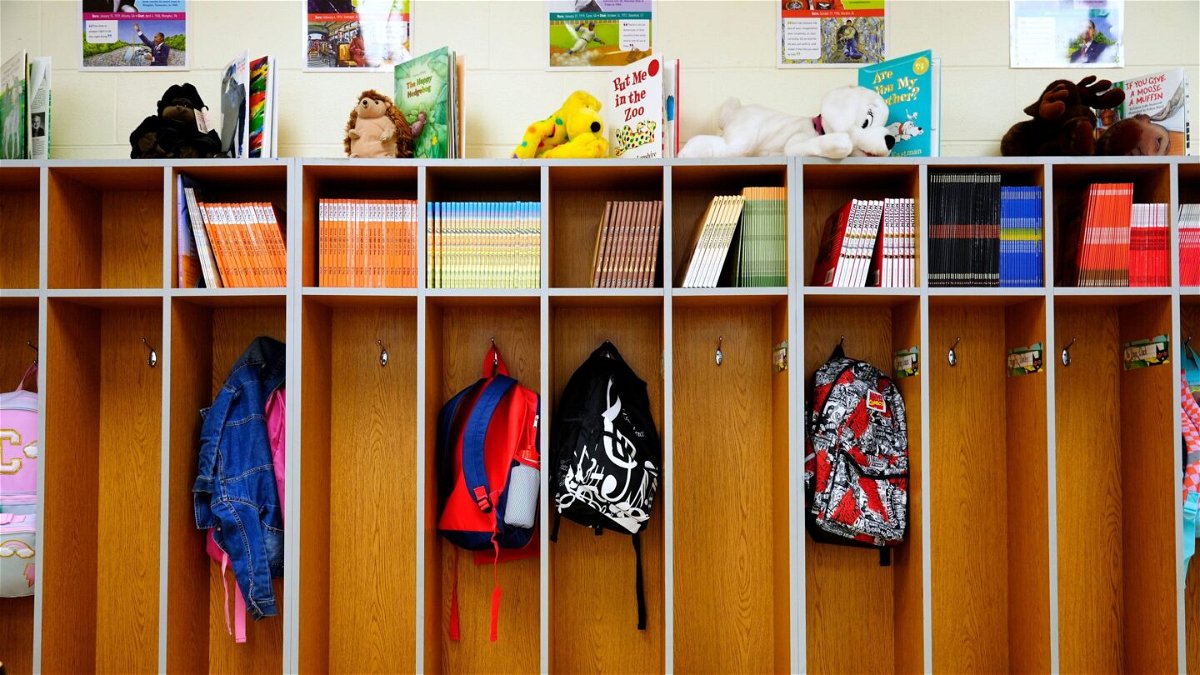Schools got $190 billion in pandemic aid, but the funds haven’t reversed learning loss

First-grade students hang up their backpacks at a public elementary school in Cincinnati on August 17.
By Katie Lobosco, CNN
Washington (CNN) — America’s K-12 schools received the largest-ever infusion of federal aid to help them address pandemic-related challenges, yet students are still struggling to catch up from the learning loss they experienced when during remote learning.
Between March 2020 and March 2021, Congress authorized $190 billion in funding for K-12 schools – roughly six times what they receive from the federal government in a normal year.
In the midst of school shutdowns, educators knew that remote learning was not as effective as in-person instruction, but the magnitude of those losses are only now becoming clear.
A June report showed that national average test scores for 13-year-olds plummeted during the 2022-23 school year when compared with pre-pandemic levels. On average, this age group scored the lowest they have in math since 1990 and the lowest in reading since 2004, according to the National Assessment of Educational Progress.
If students can’t catch up, the learning loss may impact their future earnings and even become a drag on the US economy.
“I hate to be so doom and gloom about it,” said Robin Lake, director of the Center on Reinventing Public Education, a nonpartisan research and policy analysis organization.
“But this is very serious. It’s an all-hands-on-deck moment for kids affected by Covid,” she said.
School districts, which were given a lot of leeway in how to spend the federal aid, have just one year left to use the money. Some experts say that districts may need to change the way they plan to use the money to help close the learning gap.
Why hasn’t the historic federal investment reversed learning loss?
Researchers point to several reasons why students haven’t caught up despite the massive federal investment in K-12 schools.
First, school districts did not use all of their funds to address learning loss specifically. In fact, the American Rescue Plan Act, which provided most of the pandemic aid for schools, required only that at least 20% of the funds be used to “address the academic impact of lost instructional time.”
“That’s not to say the money hasn’t been of value or didn’t provide other kinds of benefits,” said Marguerite Roza, director of the Edunomics Lab, a research center at Georgetown University.
Many districts, for example, used the money to backfill budgets to keep the schools operating as students returned to in-person learning, or for things such as mental health counseling.
Plus, the first two rounds of funding, which were appropriated in 2020, helped schools get laptops to every student learning remotely, buy cleaning supplies and improve HVAC systems.
Also, reversing the learning loss is easier said than done. Some school districts are facing a variety of challenges including staff shortages. And many school leaders say that political polarization around LGBTQ+ issues, critical race theory and Covid-19 has disrupted schooling, according to a report from the Center on Reinventing Public Education and RAND.
In a statement sent to CNN, the Department of Education said that the federal funds have gone to “proven interventions like high-impact tutoring, hiring more teachers and counselors, and a record expansion in summer learning and extended day programs,” and noted that no Republicans voted for the American Rescue Plan Act.
“While we have further to go, we are seeing increased evidence of improvement, including several states returning to pre-pandemic levels of achievement on their state math and literacy assessments, as well as promising results for the US on a recent international reading assessment,” it said.
The average student lost half a year of learning in math
Pandemic learning loss varies drastically across states and schools, but high-poverty and high-minority districts lost more ground, said Thomas Kane, faculty director of Harvard University’s Center for Education Policy Research, or CEPR.
“The average US public school student in grades 3-8 lost the equivalent of a half-year of learning in math and a quarter-year in reading,” according to the Education Recovery Scorecard, a collaboration from researchers at CEPR and Stanford University’s Educational Opportunity Project.
In the hardest-hit communities – including those like Richmond, Virginia; St. Louis; and New Haven, Connecticut – students fell behind by more than 1.5 years in math.
How can kids catch up? Add instructional time
Schools will need to add a significant amount of instructional time to help students close the learning gap – which some districts are attempting to do through tutoring, extending the school year or offering intense summer programs, for example.
In Richmond, Virginia, two of the public district’s 25 elementary schools have added 20 days to the 2023-24 school year to help students catch up after the pandemic.
“If the pilot goes well and we see significant gains in student achievement, we’ll hopefully expand to other schools next year,” Superintendent Jason Kamras wrote in a newsletter to the school community.
While many school districts are adding instructional time, they may not be operating these programs at the scale needed to reverse the learning loss.
“They’ve been launching interventions, but they’re not comparing the magnitude of the gains they should expect to the magnitude of their losses. In many cases, even if these interventions have the expected effect, there’s going to be very little catchup,” Kane said.
To put the size of the problem into perspective, Kane outlined a hypothetical, four-point plan that would produce a half-year of learning growth in math:
- Tutoring 10% of students three times per week over an entire year.
- Doubling instructional time in math for 30% of students.
- Enrolling 75% of students in summer school.
- Extending the school year by 2.5 weeks for all students.
Considering all the additional instruction time needed to catch up, it’s likely that some students will still be behind by the time the federal money runs out in September 2024.
“It’s time for state legislators and local school boards to start discussing changes in policy that they need to have in place for the fall of ’24,” Kane said.
The-CNN-Wire
™ & © 2023 Cable News Network, Inc., a Warner Bros. Discovery Company. All rights reserved.



